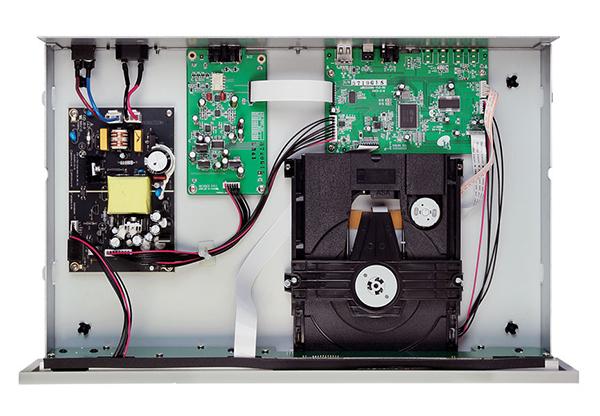JBL CD350/SA550 Classic Page 2

All Hooked Up
Otherwise, all is fairly standard here – the CD350 disc player has analogue and digital (optical/coaxial) outputs and, as PM notes, is based around a PCM1796 DAC from Texas Instruments. There’s an option to change the digital filter from the default ‘Slow’ setting in the menu system, accessed from the remote control, but as ever it was hard to hear any substantive changes from the different settings, so I stuck with the default.
As well as its two coaxial and one optical digital inputs, the SA550 offers three line-ins and an MM phono stage, plus a 3.5mm auxiliary input on the front panel. There’s also a pair of pre-out connections, an RS232 control terminal, and a USB-A port – although the latter is only for firmware upgrades, and has no audio capability. The Bluetooth implementation, with internal antenna, can handle high-resolution aptX Adaptive formats. Devices can pair with the amp even when the Bluetooth input isn’t selected, and the menu system allows the SA550 to be set to switch to Bluetooth when a paired device starts playing.
Other menu options, viewed via the amp’s orange text display, allow one input to be designated as a fixed-level connection, for example for use with the front-channel outputs of an AV source, and it’s also possible to select whether the amp’s speaker outputs are muted when headphones are plugged into the front-panel socket. It’s also here where digital filter selection can be made, alongside the usual settings for power-saving automatic standby, display brightness, and channel balance. Browsing the SA550’s ‘menu tree’ is through its Volume and Input rotaries, or from the amp’s remote, which is identical to that supplied with the CD player.
Class G Whizz
One listening tip I will give you for the CD350 is to use it purely as a digital transport, connected to the SA550 amp via optical or coaxial hook-up. Simply put, the amplifier’s ESS Sabre ES9038K2M-based digital section delivers a much more convincing performance than the somewhat lazy sound of the player’s own conversion and is very much to be preferred.
Having read that the SA550 uses Class G amplification, as championed in some higher-end models from JBL’s Harman/Samsung stablemate Arcam, you might think you’ve already got a handle on the way the unit is going to sound. Well, you’d be sort of right, as the amplifier sounds sweet and detailed at low levels, then goes on to deliver masses of power and dynamics, and a fair amount of poise, once the ‘turbocharger’ has kicked in.
But this presentation isn’t quite as mannered as memory suggests some other amps of its kind delivered: there’s not so much of that smoothness and warmth while playing at low levels, and thus less of a jolt when volumes rise, all of which is a good thing. Instead, the SA550 maintains an even balance across the volume range, and when the source allows – which isn’t always the case with the CD350 player – is capable of a performance as involving as it is thrilling, with plenty of detail and impact.
Play a set such as Golda Schultz’s Mozart, You Drive Me Crazy! recital [Alpha ALPHA1026], and while there’s some thickening of the sound when the orchestra is working hard behind the soloist, there’s a good sense of the timbre of Schultz’s voice, and plenty of dynamics and punch to the sounds. Similarly, with Isabelle Faust’s recent release of Benjamin Britten’s Violin Concerto [Harmonia Mundi HMM902668], the CD350/SA550 does a solid job of making the soloist stand out from the orchestral forces.
That said, things get a lot more persuasive when a modest streaming player – in this case the iFi Audio NEO Stream – is connected to the SA550 amp, and the same music played from network storage. Now there’s better dimensionality and ambience to the presentation of this live recording, from the opening timpani to the silky orchestral strings, and more bite to the soloist’s bow.



















































